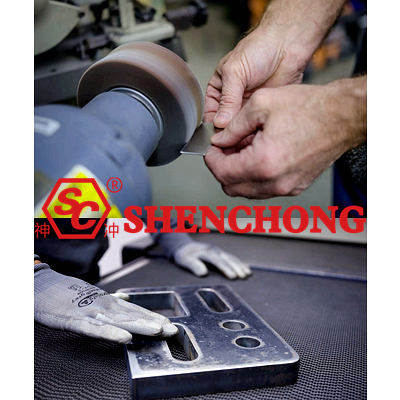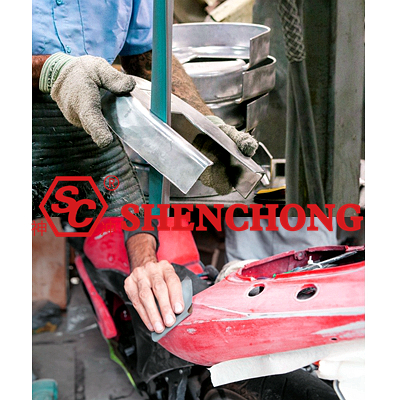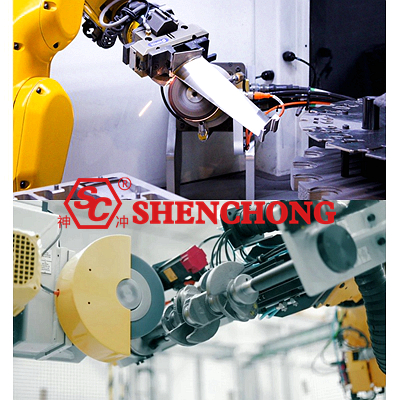
Traditional manual sheet metal deburring methods cannot meet the needs of modern industrial production. Under the pressure of factors such as product quality, production efficiency, and labor costs, the field of deburring and surface finishing technology has begun to develop towards intelligence and automation. The sheet metal deburring robot solves the industrial pain points of high cost, unstable quality and long processing cycle of manual deburring.

At present, the main methods for deburring include manual work, vibration, sandblasting, impact, explosion, mechanical processing, electrolysis, and so on. Some deburring processes have obvious shortcomings.
For example, mechanical methods such as scraper, oilstone, sandcloth, file, or grinding wheel are used to remove burrs. Time-consuming and labor-intensive. The removal efficiency is still low, the quality is poor, and the environment is polluted. Moreover, it can only be operated by visual inspection and sensation, and quality is difficult to guarantee.
The effective area for deburring by the impact method is limited and there is noise. The explosion law requires the construction of another factory building. Compared with other methods, deburring robots are the most ideal deburring process method. Especially suitable for removing burrs from hard, ductile metal materials and complex internal cavities with poor accessibility.
For a long time, the issue of burrs has not been well resolved. There are two main reasons here.
The first reason is that the burrs have not attracted enough attention. Although the deburring process is adopted in the part processing process, it has never been required to strictly solve the burr problem.
Secondly, it is very difficult to deburr some mechanical parts with high precision or complex shapes. For example: the radius of the round corner of the hydraulic servo valve reaches 0.002mm, some multi-way valve housings have many cross holes, shoulder holes, blind holes, etc.

With the increasing demand for product performance and appearance, burrs have become a direct or potential factor affecting product performance.
For example, shape and position accuracy, dimensional accuracy, surface roughness, oil leakage from hydraulic components, scratches on crankshaft bearing shells, noise from gear transmission, assembly of parts, source of cracks, circuit short circuits, etc. From this, it can be seen that "although the burrs are small, they are very harmful". In addition, burrs are also one of the biggest obstacles to reducing costs.
Under the pressure of factors such as product quality, production efficiency, and labor costs, which traditional manual deburring methods cannot meet the needs of modern industrial production, the field of deburring and surface finishing technology has begun to transform towards customization, intelligence, and automation. Polishing robots have opened a new era for the development of industrial intelligent manufacturing.

A deburring robot is a flexible machining machine that removes burrs. The equipment has stable deburring ability, high production efficiency, and is easy to achieve automated CNC.
The deburring robot solves the industrial pain points of high cost, unstable quality and long Makespan of manual deburring. Without affecting product accuracy at all, efficient and standardized production has been achieved, and robots can be customized according to the characteristics of various parts to improve the efficiency of subsequent processes. This is the ideal equipment for subsequent processing.
Relying on advanced motion control technology and focusing on the strategic positioning of high-performance and cost-effective products, Wuxi Shenchong has developed, produced, and promoted innovative products and solutions for users and markets in the sheet metal industry, and launched robot automated polishing and deburring workstations. Solve the polishing problem of small metal, die-casting products, and other non-ferrous small components such as small tools, automotive parts, household appliances, etc.
For the deburring needs of sheet metal products, our company can provide fast solutions for both deburring robot clamping tools and robot clamping products. Wuxi Shenchong automatic polishing unit adopts a floating polishing head to absorb workpiece errors, clamping errors, etc. Effectively avoiding situations where some parts cannot be machined or some parts are cut excessively during the machining process.
The deburring robot can choose different specifications of floating polishing heads according to different process requirements of the product to efficiently process various positions and process requirements of the product, such as the mold line, top rod mark, batch seam, hole inner burr, hole edge burr, surface, etc.
Laser Cutting Automatic Production Line
There are two main forms of robot sheet metal deburring automation solutions. One is the robot loading and processing the spindle, and the workpiece is fixed. The second is for the robot to grab the workpiece and fix the machining spindle. Regarding workpieces with complex structures, workpieces with scattered burrs can also correspond.
Moreover, robots have programmability, and the introduction of new products only requires the replacement of tooling and fixtures, and sequence switching can be completed. This makes the equipment more flexible and more suitable for the current needs of enterprises.
The robotic deburring solution can increase the emphasis on workers' rest or indirectly eliminate workers. Even if the initial cost of equipment investment is slightly higher, it is increasingly being borne by enterprises.